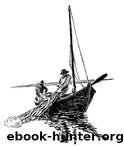The Outer Banks of North Carolina, 1584-1958 by David Stick

Author:David Stick [Stick, David]
Language: eng
Format: epub
Tags: History, United States, Colonial Period (1600-1775), State & Local, South (AL; AR; FL; GA; KY; LA; MS; NC; SC; TN; VA; WV)
ISBN: 9781469624150
Google: gNA3DwAAQBAJ
Publisher: UNC Press Books
Published: 2015-01-01T00:25:51+00:00
Diamond City
THOUGH IT WOULD be difficult to find visual evidences of it there today, one of the largest communities on the Outer Banks in the latter part of the last century was Diamond City, which was located a short distance west of the Cape Lookout Lighthouse, just beyond The Drain.
People had been living in that vicinity since the early days of Banks settlement, but the life of Diamond City itself was a short one, with a strange and unhappy ending. It was not until about 1885 that this community of several hundred persons acquired a name, yet in less than twenty years the name was about all that was left of it, for the people had moved, and when they moved they took Diamond City with themâexcept for the name, that is, and the little family graveyards where the houses used to stand.
The written records in the story of Diamond City begin as early as 1723. On September 2 of that year two Carolinians, brothers-in-law named Enoch Ward and John Shackleford, signed an agreement for the equal division of some 7,000 acres of Banks land they had acquired jointly. Their original holdings extended from Beaufort Inlet, around Cape Lookout, and up the Banks to Drum Inlet, an entire Banks island some twenty-five miles in length. In the division, Ward agreed to take the eastern half, the part known as Core Banks; Shackleford took the western half, from Cape Lookout to Beaufort Inlet.
Seven years later a man named Ebenezer Harker purchased Craney Island, containing approximately 2,400 acres and located directly across the sound from Cape Lookout and less than three miles from the Banks John Shackleford had acquired in his division with Enoch Ward. These two pieces of land, Harkers Island and Shackleford Banks, were to figure prominently in the story of Diamond City.
Equally important were the New England whalers, who made an appearance on the coast about that same time (the first permit was issued in 1726) and used Cape Lookout harbor as a base of operations as they attempted to intercept the northbound migration of whales in the early spring. They sometimes spotted the giant creatures from their anchored vessels, launched small boats for the attack, and captured the whales within sight of shore. This was not an especially profitable operation for the large whaling vessels, since the catch was spotty at best, but it set some of the Bankers to thinking. Before many years they were trying it themselves, going to sea after the whales in small pilot boats, specially designed craft which they could launch from the beach.
The extent of those early shore-based whaling operations at Cape Lookout is not known, though there are indications that one or more crews were whaling there almost continuously over a period of more than 150 years. In the 1750âs the heirs of John Shackleford sold several tracts of his Banks land, and in the deeds to Joseph Morss and to Edward Fuller in 1757, for example, it was stipulated that the purchasers should have the privilege âto fish and whale it.
Download
This site does not store any files on its server. We only index and link to content provided by other sites. Please contact the content providers to delete copyright contents if any and email us, we'll remove relevant links or contents immediately.
| Americas | African Americans |
| Civil War | Colonial Period |
| Immigrants | Revolution & Founding |
| State & Local |
In Cold Blood by Truman Capote(3304)
Steve Jobs by Walter Isaacson(2830)
The Innovators: How a Group of Hackers, Geniuses, and Geeks Created the Digital Revolution by Walter Isaacson(2826)
All the President's Men by Carl Bernstein & Bob Woodward(2326)
Lonely Planet New York City by Lonely Planet(2168)
And the Band Played On by Randy Shilts(2127)
The Room Where It Happened by John Bolton;(2101)
The Poisoner's Handbook by Deborah Blum(2089)
The Murder of Marilyn Monroe by Jay Margolis(2055)
The Innovators by Walter Isaacson(2045)
Lincoln by David Herbert Donald(1943)
A Colony in a Nation by Chris Hayes(1880)
Under the Banner of Heaven: A Story of Violent Faith by Jon Krakauer(1743)
Amelia Earhart by Doris L. Rich(1644)
The Unsettlers by Mark Sundeen(1641)
Birdmen by Lawrence Goldstone(1618)
Dirt by Bill Buford(1608)
Being George Washington by Beck Glenn(1606)
Zeitoun by Dave Eggers(1586)
